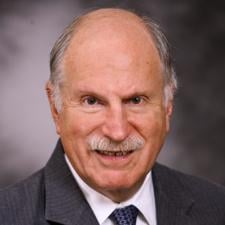As a medical student, do you ever wonder what it’s like to specialize in preventive medicine? Meet Daniel Blumenthal, MD, a preventive medicine and public health specialist and a featured physician in the AMA Wire® “Shadow Me” Specialty Series, which offers advice directly from physicians about life in their specialties. Check out his insights to help determine whether a career in preventive medicine and public health might be a good fit for you.
“Shadowing” Dr. Blumenthal
Specialty: Public health and general preventive medicine
Practice setting: Academic
Employment type: Medical school
Years in practice: 42 (retired)
A typical day and week in my practice: I was a medical school department chair. Every day was different. Some days, I taught students. Other days, I worked on research projects or manuscripts or saw patients in a neighborhood health center. I had a meeting or two on most days. A typical week was split between teaching, 10 percent; clinical patient care, 10 percent; research, 30 percent; and administration, 50 percent.
The most challenging and rewarding aspects of caring for preventive medicine patients: Most of the time, students and physicians think about patients as individuals who present themselves one at a time to a doctor in an office or a hospital. But in public health, the community is our patient, and we can go about diagnosing and treating the community using much the same thought processes as we do in treating individuals.
I teach students to think about subjective data—the kind you can collect from a survey or a focus group or a key informant interview—and objective data, such as morbidity and mortality statistics. Frequently, the objective data will lead you down a different path from what the subjective data would. It’s important to consider all of that and develop an assessment, a problem list, which may be very long—much longer than it would be for most individual patients—and then a plan for addressing those problems.
Very often, that plan will be something that involves a policy change or a piece of legislation, which might be a law requiring motorcycle riders to wear helmets or a law requiring children to be completely immunized on school entry. Those are the sorts of things that may be very difficult to convince our elected officials are important, and that may be the most difficult part of treating the community as a patient. But there are other difficult parts as well, such as convincing people to eat more vegetables, which would be undertaken on a community-wide basis.
The most rewarding aspects are seeing students graduate with a real understanding of health equity, as well as seeing improvements in health status indices and reductions in disparities.
Three adjectives to describe the typical preventive medicine specialist: Socially conscious. Oriented to the big picture. Curious.
How my lifestyle matches or differs from what I had envisioned in medical school: As a general pediatrician, the rewards had less to do with treating the self-limited diseases and more to do with watching kids grow up. But that had its limits, and I think treating sore throats and stomach aches would have bored me eventually.
Being in public health and preventive medicine has given me the opportunity to do so many different things, including teaching, research and local public health as a county health officer; national public health at the Centers for Disease Control and Prevention (CDC); international public health with the World Health Organization; and program development as a medical school department chair. That variety of experiences has kept medicine exciting for me. Also, in public health, you can save more lives than you can ever save as a clinician. You just don’t know whose lives they are.
Skills every physician in training should have for preventive medicine but won’t be tested for on the board exam: Epidemiology, health education and promotion, and policy development. For academicians, specifically: teaching and research skills.
One question every physician in training should ask themselves before pursuing this specialty: Will I be satisfied taking care of one disease or a small group of related diseases for my whole career, or would I prefer to do a variety of things that affect both individuals and populations?
Books every medical student in preventive medicine should be reading:
Maxcy-Rosenau-Last Public Health and Preventive Medicine, edited by Robert Wallace—a general reference text; the equivalent of Nelson Textbook of Pediatrics or Goldman-Cecil Medicine
Annals of Epidemiology, by Berton Roueché, or any other book by Roueché
House on Fire: The Fight to Eradicate Smallpox, by William H. Foege, MD, MPH
The online resource students interested in my specialty should follow: The CDC website.
One quick insight I'd give students who are considering preventive medicine: Do an elective at the CDC, a health department or similar. You might get to do some hands-on epidemiology, gather data on a food-borne illness or other outbreak, or even get involved in taking measures to control an epidemic, such as the Zika virus.
If I had a mantra or song to describe my life in this specialty, it would be: Public health is one manifestation of social justice, so I’d pick “Blowin’ in the Wind.”




